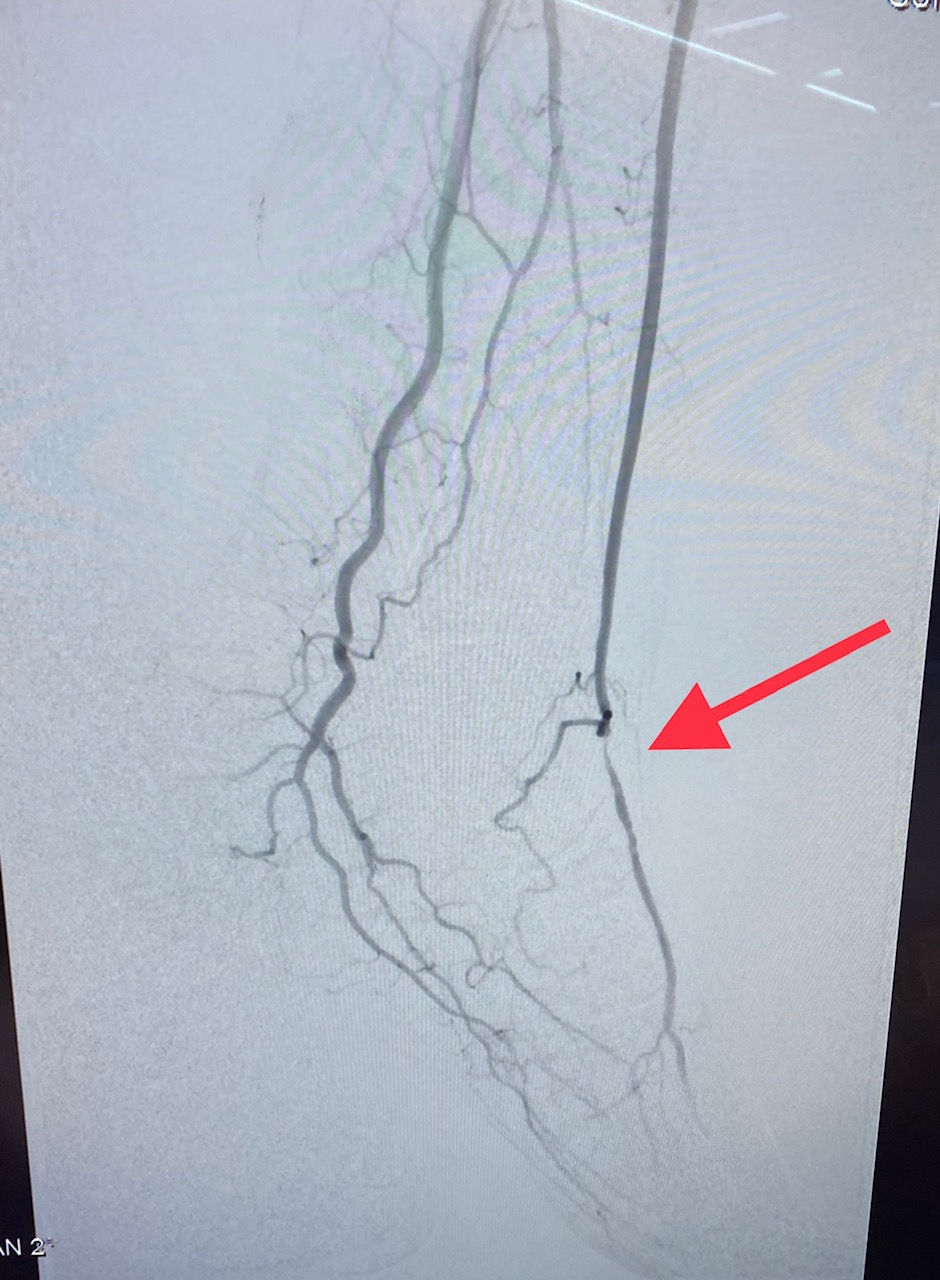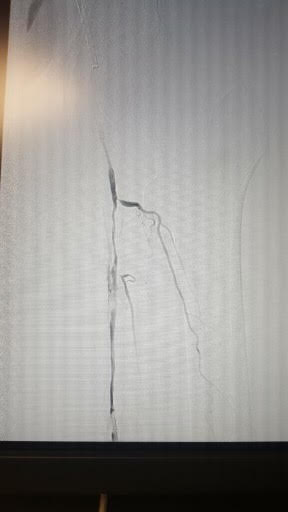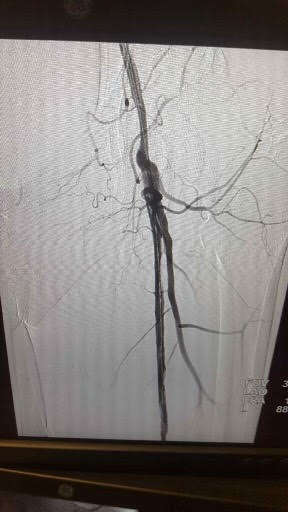[1]
Aysert Yıldız P, Özdil T, Dizbay M, Güzel Tunçcan Ö, Hızel K. Peripheral arterial disease increases the risk of multidrug-resistant bacteria and amputation in diabetic foot infections. Turkish journal of medical sciences. 2018 Aug 16:48(4):845-850. doi: 10.3906/sag-1803-217. Epub 2018 Aug 16
[PubMed PMID: 30119162]
[2]
Yuksel A, Velioglu Y, Cayir MC, Kumtepe G, Gurbuz O. Current Status of Arterial Revascularization for the Treatment of Critical Limb Ischemia in Infrainguinal Atherosclerotic Disease. The International journal of angiology : official publication of the International College of Angiology, Inc. 2018 Sep:27(3):132-137. doi: 10.1055/s-0037-1620242. Epub 2018 Jan 22
[PubMed PMID: 30154631]
[3]
Tan MNA, Lo ZJ, Lee SH, Teo RM, Tan WLG, Chandrasekar S. Review of Transmetatarsal Amputations in the Management of Peripheral Arterial Disease in an Asian Population. Annals of vascular diseases. 2018 Jun 25:11(2):210-216. doi: 10.3400/avd.oa.17-00123. Epub
[PubMed PMID: 30116413]
[4]
Simon F, Oberhuber A, Floros N, Düppers P, Schelzig H, Duran M. Pathophysiology of chronic limb ischemia. Gefasschirurgie : Zeitschrift fur vaskulare und endovaskulare Chirurgie : Organ der Deutschen und der Osterreichischen Gesellschaft fur Gefasschirurgie unter Mitarbeit der Schweizerischen Gesellschaft fur Gefasschirurgie. 2018:23(Suppl 1):13-18. doi: 10.1007/s00772-018-0380-1. Epub 2018 Apr 10
[PubMed PMID: 29950791]
[5]
Jelani QU, Petrov M, Martinez SC, Holmvang L, Al-Shaibi K, Alasnag M. Peripheral Arterial Disease in Women: an Overview of Risk Factor Profile, Clinical Features, and Outcomes. Current atherosclerosis reports. 2018 Jun 2:20(8):40. doi: 10.1007/s11883-018-0742-x. Epub 2018 Jun 2
[PubMed PMID: 29858704]
Level 3 (low-level) evidence
[6]
Kim HO, Kim W. Elucidation of the Diagnosis and Treatment of Peripheral Arterial Disease. Korean circulation journal. 2018 Sep:48(9):826-827. doi: 10.4070/kcj.2018.0155. Epub 2018 Jun 11
[PubMed PMID: 30088357]
[7]
Rafailidis V, Sidhu PS. Vascular ultrasound, the potential of integration of multiparametric ultrasound into routine clinical practice. Ultrasound (Leeds, England). 2018 Aug:26(3):136-144. doi: 10.1177/1742271X18762250. Epub 2018 Feb 28
[PubMed PMID: 30147737]
[8]
Marcadet DM, Pavy B, Bosser G, Claudot F, Corone S, Douard H, Iliou MC, Vergès-Patois B, Amedro P, Le Tourneau T, Cueff C, Avedian T, Solal AC, Carré F. French Society of Cardiology guidelines on exercise tests (part 2): Indications for exercise tests in cardiac diseases. Archives of cardiovascular diseases. 2019 Jan:112(1):56-66. doi: 10.1016/j.acvd.2018.07.001. Epub 2018 Aug 6
[PubMed PMID: 30093255]
[9]
Serhal A, Koktzoglou I, Aouad P, Carr JC, Giri S, Morcos O, Edelman RR. Cardiovascular magnetic resonance imaging of aorto-iliac and ilio-femoral vascular calcifications using proton density-weighted in-phase stack of stars. Journal of cardiovascular magnetic resonance : official journal of the Society for Cardiovascular Magnetic Resonance. 2018 Aug 6:20(1):51. doi: 10.1186/s12968-018-0479-2. Epub 2018 Aug 6
[PubMed PMID: 30078377]
[10]
Santoro L, Flex A, Nesci A, Ferraro PM, De Matteis G, Di Giorgio A, Giupponi B, Saviano L, Gambaro G, Franceschi F, Gasbarrini A, Landolfi R, Santoliquido A. Association between peripheral arterial disease and cardiovascular risk factors: role of ultrasonography versus ankle-brachial index. European review for medical and pharmacological sciences. 2018 May:22(10):3160-3165. doi: 10.26355/eurrev_201805_15076. Epub
[PubMed PMID: 29863271]
[11]
Debus ES, Kriston L, Schwaneberg T, Hischke S, Rieß HC, Härter M, Marschall U, Federrath H, Behrendt CA. Rationale and methods of the IDOMENEO health outcomes of the peripheral arterial disease revascularisation study in the GermanVasc registry. VASA. Zeitschrift fur Gefasskrankheiten. 2018 Oct:47(6):499-505. doi: 10.1024/0301-1526/a000730. Epub 2018 Aug 16
[PubMed PMID: 30113269]
[12]
US Preventive Services Task Force, Curry SJ, Krist AH, Owens DK, Barry MJ, Caughey AB, Davidson KW, Doubeni CA, Epling JW Jr, Kemper AR, Kubik M, Landefeld CS, Mangione CM, Silverstein M, Simon MA, Tseng CW, Wong JB. Screening for Peripheral Artery Disease and Cardiovascular Disease Risk Assessment With the Ankle-Brachial Index: US Preventive Services Task Force Recommendation Statement. JAMA. 2018 Jul 10:320(2):177-183. doi: 10.1001/jama.2018.8357. Epub
[PubMed PMID: 29998344]
[13]
Jin J. Screening for Peripheral Artery Disease With Ankle-Brachial Index. JAMA. 2018 Jul 10:320(2):212. doi: 10.1001/jama.2018.9112. Epub
[PubMed PMID: 29998339]
[14]
Shabani Varaki E, Gargiulo GD, Penkala S, Breen PP. Peripheral vascular disease assessment in the lower limb: a review of current and emerging non-invasive diagnostic methods. Biomedical engineering online. 2018 May 11:17(1):61. doi: 10.1186/s12938-018-0494-4. Epub 2018 May 11
[PubMed PMID: 29751811]
[15]
Expert Panel on Vascular Imaging:, Cooper K, Majdalany BS, Kalva SP, Chandra A, Collins JD, Francois CJ, Ganguli S, Gornik HL, Kendi AT, Khaja MS, Minocha J, Norton PT, Obara P, Reis SP, Sutphin PD, Rybicki FJ. ACR Appropriateness Criteria(®) Lower Extremity Arterial Revascularization-Post-Therapy Imaging. Journal of the American College of Radiology : JACR. 2018 May:15(5S):S104-S115. doi: 10.1016/j.jacr.2018.03.011. Epub
[PubMed PMID: 29724414]
[16]
Kawarada O, Zen K, Hozawa K, Ayabe S, Huang HL, Choi D, Kim SH, Kim J, Kato T, Tsubakimoto Y, Nakama T, Ichihashi S, Fujimura N, Higashimori A, Fujihara M, Sato T, Yan BP, Pang SY, Wongwanit C, Leong YP, Chua B, George RK, Yokoi Y, Motomura H, Obara H. Contemporary critical limb ischemia: Asian multidisciplinary consensus statement on the collaboration between endovascular therapy and wound care. Cardiovascular intervention and therapeutics. 2018 Oct:33(4):297-312. doi: 10.1007/s12928-018-0523-z. Epub 2018 Apr 13
[PubMed PMID: 29654408]
Level 3 (low-level) evidence
[17]
van Baal JG, Aan de Stegge WB, Schaper NC. [A multidisciplinary approach in diabetic foot disease is mandatory]. Nederlands tijdschrift voor geneeskunde. 2017:161():D1755
[PubMed PMID: 29057728]
[18]
Hartmann B, Fottner C, Herrmann K, Limbourg T, Weber MM, Beckh K. Interdisciplinary treatment of diabetic foot wounds in the elderly: Low risk of amputations and mortality and good chance of being mobile with good quality of life. Diabetes & vascular disease research. 2017 Jan:14(1):55-58
[PubMed PMID: 27941057]
Level 2 (mid-level) evidence
[19]
Chan AS, Montbriand J, Eisenberg N, Roche-Nagle G. Outcomes of minor amputations in patients with peripheral vascular disease over a 10-year period at a tertiary care institution. Vascular. 2019 Feb:27(1):8-18. doi: 10.1177/1708538118797544. Epub 2018 Aug 29
[PubMed PMID: 30157719]
[20]
Prouse AF, Langner P, Plomondon ME, Ho PM, Valle JA, Barón AE, Armstrong EJ, Waldo SW. Temporal trends in the management and clinical outcomes of lower extremity arterial thromboembolism within a national Veteran population. Vascular medicine (London, England). 2019 Feb:24(1):41-49. doi: 10.1177/1358863X18793210. Epub 2018 Aug 14
[PubMed PMID: 30105938]
Level 2 (mid-level) evidence
[21]
Akagi D, Hoshina K, Akai A, Yamamoto K. Outcomes in Patients with Critical Limb Ischemia due to Arteriosclerosis Obliterans Who Did Not Undergo Arterial Reconstruction. International heart journal. 2018 Sep 26:59(5):1041-1046. doi: 10.1536/ihj.17-592. Epub 2018 Aug 11
[PubMed PMID: 30101855]





